Key Points
- On 10 August 2023, ADS-B became mandatory in Canadian Class A airspace – that’s everything above FL180.
- It was the first phase of a progressive rollout, thanks to space-based technology. Class B will follow on 16 May 2024, while the other classes are slated for 2026.
- A new AIC has been published with all the info, which you can find here. The key points are summarized below.

The ADS-B mandate is being rolled out to all domestic Canadian airspace.
What equipment do I need?
- A transponder with ADS-B out capability that meet the minimum performance standards (or better) found in this fancy document. This needs to be attached to an antenna that can broadcast to ADS-B receivers both on the ground, and in space.
- You can also find more on this in section 551.103 of the Canadian Aviation Regulations.
Extra Flight Planning Requirements
- If you plan on entering airspace where the ADS-B mandate applies, there is some extra stuff you need to include in item 10b of your ICAO flight plan (assuming you have all the right gear on board).
- Use the code ‘B1’ if you have ADS-B Out only, or ‘B2’ if you have ADS-B In and Out.
- You’ll also need to include ‘SUR/CANMANDATE’ in item 18.
- One other gotcha – make sure the flight identification (flight number or aircraft reg) broadcast by your ADS-B equipment exactly matches the one used in item 7 of your flight plan. Lest there be trouble down the track!
My ride doesn’t have this fanciness. What are my options?
- NAV CANADA will do their best to accommodate aircraft who don’t have the right gear on board, in the same way they’ll work to fit non-transponder equipped aircraft into transponder mandatory airspace.
- They’ll assess each application on a first-come, first-served basis. It takes time to figure out behind the scenes, and so you’ll need to ask at least three business days before your flight.
- There may also be suggested re-routes to make your request possible, along with special comments to include in Item 18 of your flight plan.
- You can apply for an exemption online, here. If you have a number of flights to operate, you can also submit a blanket request via service@navcanada.ca.

To enter mandated airspace without ADS-B, you’ll need prior approval. Click the image above for that.
90 Day Grace Period
- From now until November 8, a grace period is being applied. It’s not really a ‘get out of jail free’ card, but is designed to help operators come to terms with the changes.
- No aviation occurrence reports (AORs) will be filed during this period if a non-equipped aircraft happens to enter without approval. There is still an expectation that the proper procedures will be followed.
More Info
You can find that in the Canadian AIP (ENR 1.6.3). You can also contact NAV CANADA directly on 800-876-4693, or via service@navcanada.ca.
More on the topic:
- More: US FAA: Swift Move to Improve Flight Tracking Privacy
- More: ADS-B Mandates in 2023
- More: Cloaking Devices: The ADS-B Privacy Issue
- More: Canada: The AGN and what to do with it
- More: Are you ADS-Being watched?
More reading:
- Latest: Teterboro: RIP the RUUDY SIX
- Latest: 400% increase in GPS Spoofing; Workgroup established
- Latest: GPS Spoofing WorkGroup 2024
- Safe Airspace: Risk Database
- Weekly Ops Bulletin: Subscribe
- Membership plans: Why join OPSGROUP?











 Get the famous weekly
Get the famous weekly 





